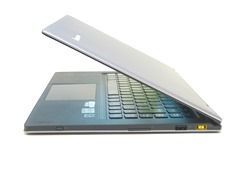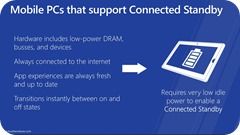 The Verge have published a nice piece about what’s coming to the Ultrabook scene later in 2013. We’ve already reported on the Touchscreen and WiDi requirement (and what it really means) but via an interview with Kirk Skaugen we’re given a few more interesting statements. The biggest of which is a confirmation that Connected Standby is coming.
The Verge have published a nice piece about what’s coming to the Ultrabook scene later in 2013. We’ve already reported on the Touchscreen and WiDi requirement (and what it really means) but via an interview with Kirk Skaugen we’re given a few more interesting statements. The biggest of which is a confirmation that Connected Standby is coming.
All-day battery life on Windows-based PCs has been a promise for years but Kirk says that Intel really means it this time. Given the huge, huge step that Atom Clovertrail on Windows 8 has made over the previous generation with Windows 7, it’s highly likely that it will happen, at least in moderate usage scenarios.
 Intel finally mentions Connected Standby too. Although The Verge doesn’t seem to have grasped exactly what that means (likening it to Power Nap on OSX when it’s actually a truly always-on state – more info here) they at least get Intel to say the words we wanted to hear. This is great news. So great that you have to wonder how it might affect H1 2013 sales when people start to realize what’s coming.
Intel finally mentions Connected Standby too. Although The Verge doesn’t seem to have grasped exactly what that means (likening it to Power Nap on OSX when it’s actually a truly always-on state – more info here) they at least get Intel to say the words we wanted to hear. This is great news. So great that you have to wonder how it might affect H1 2013 sales when people start to realize what’s coming.
There’s a little bit of news about WiDi 3.5 too as Miracast support will be rolled up into the specification making it much more interoperable. We’re also expecting WiDi Pro to allow collaboration too.
Head over to The Verge and make sure you read through some of the comments too. Haswell Ultrabooks are estimated to launch around the Computex timeframe (beginning of June) with first availability in July/August, effectively echoing the Ultrabook 2012 timeline.











I just hope that June 2nd is a proper hard release with lots of product available to actually be purchased because I have to do my tri-annual corporate refresh by June 30…
Asus devices with WIDI sounds pretty nice.
On a related note, anyone know if the Zenbook Prime Touch has WIDI? (Because I’ll just quit stalling and buy it now if it does -it just made my corporate refresh list)
Adam
1st Availability July/August??
No Haswell for me… ; (
Sad, sad day.
Adam
How does Intel define all day battery life in terms of usage and duration? How does Haswell increase battery life so much from the current ~5 hours with minimal use? From my understanding, Intel’s chip may not be the number 1 battery draw in many usage scenarios.
I can’t get excited about connected standby with a notebook. Whenever my notebook is in sleep mode, there aren’t any WiFi networks to connect to and mobile broadband is too expensive where I live.
About connected standby, does your W510 meet the 5% drain over 16 hours requirement during connected standby? Thanks.
With no problem at all. It’s hard to measure accurately but with nothing running in background (that’s what the test is) i estimate 100mw drain which is about 10% per 24hrs. (tablet only)
With Skype, tweetro, email running in the background it will do about 4 days worth of connected standby. (tablet only)
Streaming audio it will do about 30hrs of connected standby. (tablet only)
These figures shouldn’t be much different for a Haswell CPU although remember that Ultrabooks will have 50-100% bigger batteries than the W510 tablet.
[Figures from the top of my head. I’ve done lots of testing in this area]
8-10 hours.
Yes, you are right about chip not being the #1 power use, but that’s not what Haswell addresses. Since 5 years ago, Intel has been working extensively with hardware and software manufacturers to devise new power states.
Connected Standby in Windows 8 is related, because the technologies in Haswell that allows power use to go way down is what makes it meet Connected Standby requirements.
Do you see how your CPU core can go down into hundreds of mW power state at lowest, but can go to 10W+? Well, the rest of the platform does not scale down so far, but Haswell allows that.
Everything except the display it’ll go into what Intel calls “S0iX”. Think of it as S0 wake up time but S3 power use. Another word for description is “Active Standby”. With Haswell even the display can go into lower power with Panel Self Refresh.
You make a good point about not having WiFi access when laptop is asleep (meaning you are traveling between working zones I assume.) but there are also advantages of having the technology and not using Connected Standby. The ‘reading’ scenario get’s a big boost for example. I estimate 100% more battery life in this scenario because of the technology involved.
Video playback is another (expect near 100% battery life increase in this Scenario) Of course, these are my estimates, not tested…yet!
Chippy